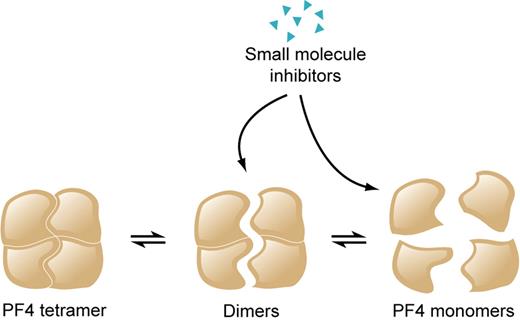Current methods of treating heparin-induced thrombocytopenia (HIT) focus on treatment and prevention of thrombotic complications. In this issue of Blood, Sachais et al describe a novel therapeutic approach: pharmacologic disruption of PF4 tetramers essential for formation of immune complexes that are central to the pathogenesis.1
Despite significant progress in diagnosis and treatment, HIT remains an important cause of morbidity in patients treated with this widely used anticoagulant.2 Although thrombocytopenia is a hallmark of HIT, platelet counts are rarely low enough to precipitate bleeding; rather, thrombosis, occurring acutely or even weeks after discontinuation of heparin, is the major threat to affected patients. It is now well understood that antibodies specific for conformational changes induced in the CXC chemokine platelet factor 4 (PF4) when it binds to heparin or to another glycosaminoglycan (GAG) are central to HIT pathogenesis. How these antibodies trigger thrombosis in a patient treated with heparin is not yet fully understood, but it is known that immune complexes consisting of heparin, PF4, and antibodies of the IgG classes induce procoagulant activity in platelets and possibly other target cells by activating the cell surface receptor FcλRIIa.2,3 Accordingly, current treatment of HIT is aimed at controlling the procoagulant state associated with this condition through use of direct thrombin inhibitors, vitamin K antagonists, and other approaches.4 Although antithrombotic treatment is often effective, especially when implemented early, it does not affect the ability of persisting HIT antibodies to perpetuate thrombotic risk, even after heparin is withdrawn.5,6
Sachais et al describe studies that support the feasibility of a novel, previously untested approach to HIT treatment.1 The PF4 molecule is a 32kD tetramer normally in equilibrium with its dimeric and monomeric subunits.7 Previous studies showed that PF4 mutated at residue 50 from K to E is incapable of forming tetramers or of producing large complexes capable of binding antibody when incubated with heparin.8 Sachais et al used in silico computational analysis to screen a library of more than 1 million organic compounds and identify those that might be capable of binding to PF4 at or near lysine-50, thereby interfering with tetramer formation. Four candidate small molecules were identified that, when tested, were found, at micromolar concentrations, to inhibit both PF4 tetramer formation and production of large PF4-heparin complexes (see figure). Three of the 4 also caused preformed immune complexes consisting of PF4, heparin, and HIT antibodies to become incapable of activating the FcλRIIa receptor.
Sachais et al describe small molecule inhibitors that dock to platelet factor 4 (PF4) at sites that are critical for multimerization and, at micromolar concentrations, promote dissociation of PF4 tetramers into dimers and monomers. If these agents act similarly in vivo, they could provide a means of preventing and disrupting the immune complexes that are central to heparin-induced thrombocytopenia (HIT) pathogenesis. Professional illustration by Kenneth X. Probst.
Sachais et al describe small molecule inhibitors that dock to platelet factor 4 (PF4) at sites that are critical for multimerization and, at micromolar concentrations, promote dissociation of PF4 tetramers into dimers and monomers. If these agents act similarly in vivo, they could provide a means of preventing and disrupting the immune complexes that are central to heparin-induced thrombocytopenia (HIT) pathogenesis. Professional illustration by Kenneth X. Probst.
The approach explored by Sachais et al suggests the possibility of a treatment for HIT that directly addresses the underlying pathogenesis by “inactivating” PF4 and disrupting the immune complexes that play a critical role in promoting procoagulant activity and thrombosis. In addition to this immediate therapeutic effect, the strategy could, in theory, prevent HIT antibodies persisting after discontinuation of heparin from triggering new thromboses by recognizing PF4 bound to surface GAG molecules on platelets and other target cells.5,9 Conceivably, it might even be possible to continue heparin in a patient who has antibodies but lacks functional PF4 as a result of this pharmacologic intervention! Because mouse models are now available in which a syndrome closely resembling human HIT can be induced,10 it should now be possible to test in vivo the effectiveness of the compounds identified in this study. Further developments will be watched with great interest.
Conflict-of-interest disclosure: The author declares no competing financial interests. ■


This feature is available to Subscribers Only
Sign In or Create an Account Close Modal